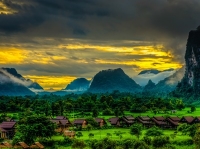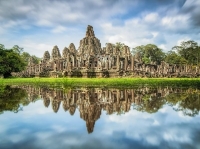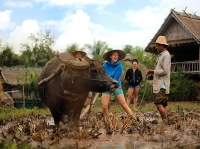History of Wat Phou
Wat Phou or Vat Phu refers to mountain temple. The wat used to be a part of the Khmer Empire in the early 10th century. Later, the original structures were replaced, some of the stone blocks were reused. The current temple was built between the late 10th and early 11th century. A variety of further details were changed during the next two centuries. Primarily, Wat Phou was to dedicate to Shiva, one of the Gods of the Hindu. In the 13th century, like most other temples, it was converted into a Buddhist temple. Today, Vat Phu is still considered as a place of worship by local Buddhists. The wat was designated a World Heritage Site in 2001.
Highlights of Wat Phou
The different structures of the Vat Phu are built on seven terraces, lined on an axis from the Mekong river bank towards the mountain. The north and south palaces on a terrace include rectangular courtyards with passages and entrances on the side towards the axis, false doors at the east. The walls of the courtyards are laterite. While the northern palace's corridor has laterite walls, the southern palace’s corridor has sandstone ones. The pediments and lintels of the palaces are quite oustanding because of their early Angkor Wat style, complex carvings of God and mythical creatures such as Shiva, Nandi, a sacred bull. It is believed that Hindu ceremonies were taken place in these buildings. There is also a small shrine to the sacred bull Nandi (the gate guardian deity) on the following terrace. The rest of six small brick shrines destroyed by treasure hunters are on the narrow next terraces.


The sanctuary is later than the two palaces and estimated to be constructed in the late 11th century. The east side has three doors features images of deities and animals in Hinduism and Buddhism. Dvarapalas, giant door guardians, are placed on the east wall. The sanctuary is divided into two sections. The front part is made by sandstone and contains four Buddha statues in saffron robes. Whereas the back one of brick is empty despite enshrining the linga, the representation of Shiva many years ago. The water from the mountain spring was channeled towards the linga and constantly bathed the linga.
Furthermore, there is a series of barays directly along the Wat Phou axis. But among these barays, only one now is still used to contain water. There are further reservoirs at the northern and southern wat. Other notable features Vat Phu are a library and carvings such as a Buddha footprint on the cliff, elephants and a crocodile.
Wat Phou festival is called Boun Wat Phou Champasak by the locals. The festival is held at the full moon of the 3rd lunar month. During the 3 day festival, Laotians crowd into Wat Phou to respect the Buddha and bring offerings. If participating in this biggest annual festival of the wat, visitors will have a chance to experience a large number of impressive ceremonies and exciting activities like monk-blessing ceremonies, elephant racing, buffalo and cock fighting, Lao traditional dance and musical performances.
Opening Hours and Price to Wat Phou
The temple opens daily from 8 am until 4:30 pm. The price of admission is 30,000 kips or 45,000 kips including a ride to the entrance gate.














